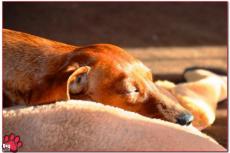Active dachshunds have lower risks for IVDD
How can owners of dachshunds lower chances for IVDD, the typical type of paralysis in the breed, as much as possible? This question was the main issue in research done after the incidence and risks of this problem, also known as intervertebral disc disease. IVDD is the most common problem in dachshunds. An estimated 1 out of 4 dachshunds has to deal with it sooner or later.
Packer et. al published in Canine Genetics and Epidemiology. Because IVDD is a hereditary disorder. Unfortunately it is not a simple problem to be found on a single set of genes. Would that be the case, it would be fairly simple to rule the problem out of the breed. But IVDD is polygenetic, ie devided over several genes. And like in hip dysplasia environmental factors have a large influence on the possible development of IVDD.
The survey was done by questionnaires and interviews with over 2,000 owners of dachshunds, most of them from England. About 20% of the dogs was from the continent, Australia or other places.
Standard smooth has a larger chance
The standard smooth haired dachshund turned out to be the one with the largest chances for IVDD (1 out of 4), in the standard wire haired only 1 out of every 14 dogs gets this problem. The standard long haired was somewhere in between. Distinction between miniature and rabbit wasn’t made in this survey.
Another unexpected result was males and females have equal chances, neutered and intact have not. Intact dogs turned out to have fewer IVDD (9%) then neutered dogs (21%).
Moving helps
Any owner of a dachshund that is hardly to never allowed to run off the leash is taking a pretty large risk. Dos that gets exercised on a daily basis, and we are talking good exercise here, are less likely to this problem then the coach potatoes. And oh yes, allow your dog to get on that coach, because dogs jumping on coaches also are less likely to get IVDD. That is remarkable since jumping is one of the things most vets tell you not to allow your dachsie to do. Even showing your dog has consequences: show dogs don’t have as often IVDD as non-showers do. Walking stairs also reduces the risk.
The explanation for all this is simple the researchers say: more active means more muscles and therefore less IVDD. Nutrition didn’t show any influence (although dogs with glucosamine and/or chondroitin in their diet had more IVDD, but since they were given this because of the IVDD there is no relevance to it).
Summarizing it all this means that anyone trying to protect a dachshund from IVDD should make sure the dog gets plenty of exercise and make sure it is not neutered. And as a bonus: exercise is good for owners as well as the dogs.
bron
DachsLife 2015: an investigation of lifestyle associations with the risk of int…





